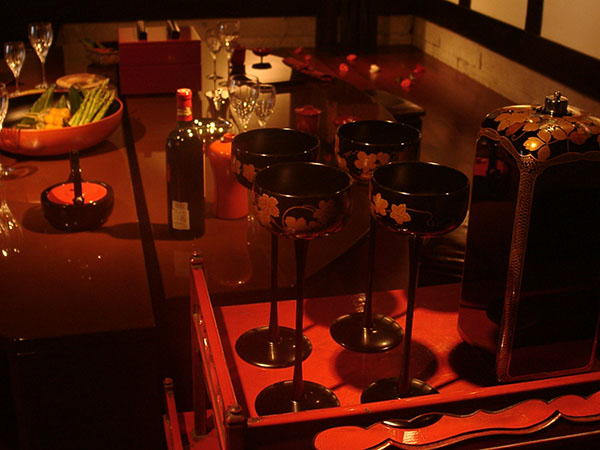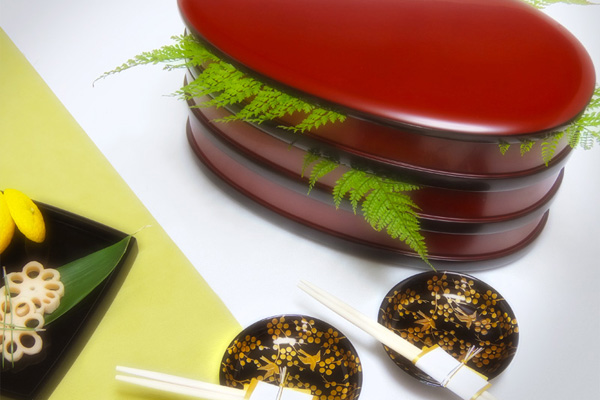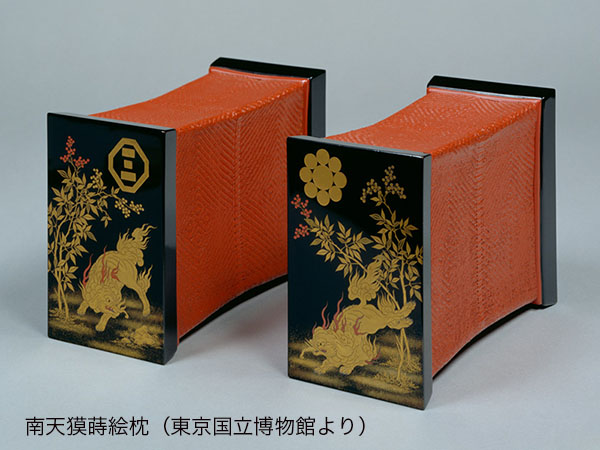The gentleness of lacquer to heal the heart
What image comes to mind when you hear the word “Urushi”(Japanese lacquer)?
Let’s start with a story we heard from a female customer living in Tokyo.
Is lacquer spoon a magic spoon?
“One time, my elderly mother was not feeling well, she was feeling depressed and gradually lost her appetite. I took her meals to her bed and fed her, but she stopped taking her daily meals and I became more and more worried as she was getting weaker day by day.
 One day at mealtime, instead of the metal spoon she usually used, I casually decided to use a lacquered spoon I had bought some time ago. ‘It’s a magic spoon,’ I said, as I put food on the lacquered spoon and fed it into her mouth. She smiled for the first time in a long time, as if suddenly at peace, and she ate more than usual that day. She seemed to feel better than at any time after that, so I tried to use a lacquer spoon every day from then on. Gradually, my mother began to enjoy eating more and more, and her illness gradually started to improve, and she eventually regained her full strength!”
One day at mealtime, instead of the metal spoon she usually used, I casually decided to use a lacquered spoon I had bought some time ago. ‘It’s a magic spoon,’ I said, as I put food on the lacquered spoon and fed it into her mouth. She smiled for the first time in a long time, as if suddenly at peace, and she ate more than usual that day. She seemed to feel better than at any time after that, so I tried to use a lacquer spoon every day from then on. Gradually, my mother began to enjoy eating more and more, and her illness gradually started to improve, and she eventually regained her full strength!”
She was very surprised and said that this was the start of her love of lacquerware.
The gentle texture and soft mouth feel of lacquer seems to have the power to strongly influence people’s minds unconsciously in such a way. Japanese people eat with the vessel in their hands, and perhaps the sense of tasting the vessel on their skin has been firmly imprinted in their long history.
Beauty unchanged for thousands of years
Our ancestors have been using lacquer on everything around them for more than 9,000 years. From tableware, ornaments and armour, such as bows and arrows, to furniture and buildings. Even objects excavated thousands of years ago have not lost their amazing brilliance and beauty.
 The warm texture of the lacquer on the hands and lips. The texture of vermilion lacquer, which has undergone a long history of weathering and still retains its deep taste and beauty. The brilliance of the “maki-e” and “chinkin” that shines through the absorbing jet-black lacquer. Novelist Tanizaki Junichiro praised the beauty of “maki-e” in the soft light coming through shoji screens in his “In-ei Reisan (In Praise of Shadows)”, saying that this is the beauty of Japan. Lacquer has been widely used not only in Japan but also in Korea, China and Southeast Asia, but no other country has been as fond of lacquer and has developed the art of lacquer craft in such variety and sophistication as Japan. Lacquer is the very heart of Japan.
The warm texture of the lacquer on the hands and lips. The texture of vermilion lacquer, which has undergone a long history of weathering and still retains its deep taste and beauty. The brilliance of the “maki-e” and “chinkin” that shines through the absorbing jet-black lacquer. Novelist Tanizaki Junichiro praised the beauty of “maki-e” in the soft light coming through shoji screens in his “In-ei Reisan (In Praise of Shadows)”, saying that this is the beauty of Japan. Lacquer has been widely used not only in Japan but also in Korea, China and Southeast Asia, but no other country has been as fond of lacquer and has developed the art of lacquer craft in such variety and sophistication as Japan. Lacquer is the very heart of Japan.
Living Artworks, art in daily life
Unobtrusive richness
Today in Japan, we take words such as ‘art’ and ‘fine art’ for granted, but in fact these words were created in the Meiji era (17C).In the past, Japanese people were unaware of such words and concepts, and used a variety of ingenious techniques to create beautiful and comfortable objects, even for trivial tools, to casually add colour to their lives around them.
 We call these various objects, which beautified the lives of people and improved the quality of our lives, “Living Artworks”. As advocated by William Morris of the Arts & Crafts movement in 19th century England, which also influenced Yanagi Muneyoshi’s “Mingei(folk art)” movement, our products are produced with the aim of becoming “Living Artworks” that gently accompany our customers in their daily lives.
We call these various objects, which beautified the lives of people and improved the quality of our lives, “Living Artworks”. As advocated by William Morris of the Arts & Crafts movement in 19th century England, which also influenced Yanagi Muneyoshi’s “Mingei(folk art)” movement, our products are produced with the aim of becoming “Living Artworks” that gently accompany our customers in their daily lives.
Vessels that are nurtured by the people who use them
Lacquer is also known as living paint. Lacquer vessels are born in the workshop, but as they are used, they change their appearance day by day, gradually gaining a bottom luster that seems to bounce back from the depths of the paint film, becoming a vessel that is unique to that person. Time accumulates and grows on each lacquer vessel, adding to its unique depth and beauty. It can be said that the beauty of lacquer is not perfected by the maker, but by the user. The medieval “Negoro” lacquerware that has been handed down to the present also has a withering taste that new-born lacquerware cannot quite match.
A culture of mutual enjoyment between user and producer
Lacquerware designs have often depicted seasonal patterns such as flowers, birds, wind and moon, landscapes, or illustrations of poetry, stories and folklore. The creator tries to convey a scene or meaning to the user with ingenuity and devotion. The user also tries to imagine and understand the intentions of the creator.
 For example, there was a wood pillow with some unusual animals drawn in “maki-e”. If a stranger looked at it, it depicted an animal that looked like a cow, an elephant, a pig or something else that was not clear. This is actually a fictional animal called a “Baku” (tapir), which is said to eat bad dreams, and was drawn in the hope that people using this pillow would not have nightmares. If it ends up being an unfamiliar animal, nothing will be conveyed about the creator’s intentions.Conversely, if the subject matter was too commonplace and devoid of ingenuity, the user would be looked down upon. There was a culture of exchanging minds through objects, competing and enjoying each other’s good taste and insight.
For example, there was a wood pillow with some unusual animals drawn in “maki-e”. If a stranger looked at it, it depicted an animal that looked like a cow, an elephant, a pig or something else that was not clear. This is actually a fictional animal called a “Baku” (tapir), which is said to eat bad dreams, and was drawn in the hope that people using this pillow would not have nightmares. If it ends up being an unfamiliar animal, nothing will be conveyed about the creator’s intentions.Conversely, if the subject matter was too commonplace and devoid of ingenuity, the user would be looked down upon. There was a culture of exchanging minds through objects, competing and enjoying each other’s good taste and insight.
What you need to spend time on
The more time you spend on it, the better it gets
 Lacquerware making may be said to be the result of a long process of sedimentation. Painting and grinding are repeated many times. After painting, the lacquer needs time to “lie down”, to wait for the lacquer, which is a living paint, to harden and blend with the layers below.
Lacquerware making may be said to be the result of a long process of sedimentation. Painting and grinding are repeated many times. After painting, the lacquer needs time to “lie down”, to wait for the lacquer, which is a living paint, to harden and blend with the layers below.
In addition, we often use the terms ‘lacquer dries’ and ‘lacquer withers’ separately. Even if the lacquer appears to have hardened on the surface, the true strength and beauty of the lacquer cannot be demonstrated unless it is allowed to ‘withered’ deep into the lacquer layer. It is often said that “children who sleep well grow up well”, and the same can be said for making good lacquerware.
Staying with the pace of nature
In addition, all lacquerware is made from natural materials. It takes a long time to obtain nature’s bounty. It takes at least 15 years for a lacquer tree to grow to the point where lacquer can be harvested. The wood takes decades to grow, and it takes five to ten years to dry naturally until it can be processed after it has been felled. Diatomaceous earth, which is mixed into the base coat, is a fossilised form of algae dating back 100 million years.
Today, everything is becoming faster and faster. However, there are certainly jobs that can only be done with time and effort, and jobs that get better the more time you spend on them, even in this day and age.
